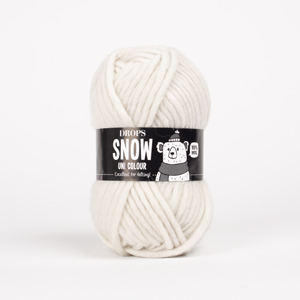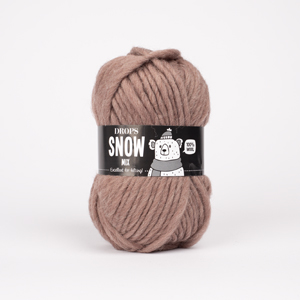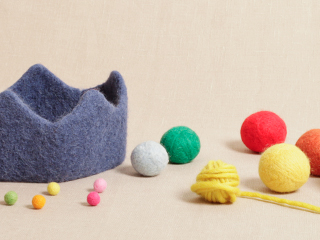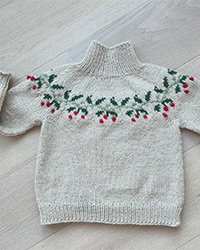Comments / Questions (37)
![]() Thea wrote:
Thea wrote:
Wie lange muss ich die Arbeit bei 40C° in der Waschmaschine filzen? Und kann ich auch Waschmittel benutzen, oder muss es Schmierseife sein?
18.07.2025 - 18:22DROPS Design answered:
Liebe Thea, in der Regel reichen ca. 40 Minuten bei 40 °C im normalen Waschprogramm. Bitte kein Kurzprogramm verwenden. Schmierseife wird empfohlen, ist aber kein Muss – alternativ kann auch ein Vollwaschmittel verwendet werden. Mehr Infos finden Sie unter diesem Link. Viel Spaß beim stricken!
18.07.2025 - 19:06
![]() Hanna wrote:
Hanna wrote:
Dzień dobry, zrobiłam torbę z pomponem. Po sfilcowaniu pompon się rozwarstwia, nie jest ścisły. Dałam dużo wełny Dlaczego, jaki błąd zrobiłam? Hanna . Jaki
08.02.2025 - 18:05DROPS Design answered:
Witaj Haniu, albo było w nim za mało nitek, albo był za luźno związany. Trudno powiedzieć. Spróbuj sfilcować go jeszcze raz, włóż do pralki razem z innymi ubraniami. Pozdrawiamy!
10.02.2025 - 11:57
![]() Pam Moloney wrote:
Pam Moloney wrote:
Under the instructions for the striped bag it says see corrections for assembly but there are no corrections to see.Has it already been corrected? Pam
19.01.2025 - 21:48DROPS Design answered:
Dear Pam, yes, that's correct. We correct the version online, so the pattern that you can find here has already been corrected. The correction notification is for those that printed the pattern before the correction was done, so that they know that the pattern has been modified. So you can follow the online version; it's the correct version. Happy knitting!
19.01.2025 - 22:39
![]() Hanna wrote:
Hanna wrote:
Dzień dobry, robię torobkę z pomponem. Zrobiłam już przód. Mam pytanie. Jak zszyć przód z tyłem i potem spód torby. Na której stronie zszywać i jakim ściegiem? Włóczka jest gruba. Czy do zszywania użyć też włóczkę Snow czy może nitkę rozdzielić na połowę.Ile włóczki przeznaczyć na pompon? Pozdrawiam serdecznie Hanna Jasińska
06.01.2025 - 19:33DROPS Design answered:
Witaj Haniu, popatrz na instrukcje video, które znajdują się pod tytułem wzoru. Nie martw się grubością włóczki. Szwy staną się niewidoczne po filcowaniu. Pozdrawiamy!
07.01.2025 - 12:12
![]() Pam Moloney wrote:
Pam Moloney wrote:
Is it possible to reply to your reply to my question?
23.12.2024 - 21:27DROPS Design answered:
Dear Pam, unfortunately it's not possible. But you can mention your previous question in your new question and we will take both the previous question and answer into consideration when answering to your new question. Happy knitting!
29.12.2024 - 20:01
![]() Pam Moloney wrote:
Pam Moloney wrote:
I have just finished knitting the bag with the pom pom.It is the right size pre felted I e 34 cms wide and 48cms long.I haven't added the pom pom but I have only used 250 g not 350g as pattern states. Do you think the yarn requirement is incorrect as I don't think the pom pom could take 100g to complete could it ? Or am I wrong?
21.12.2024 - 19:35DROPS Design answered:
Dear Pam, have you done the strap and the loops for the pompom? These 2 plus the pompom may need something similar to 100gr. It also may vary depending on your working gauge, if you work slightly loosely than stated then you will work less rows, so you will have used less yarn; check the working gauge, since a variation in the working gauge may affect the final felted bag size. Happy knitting!
22.12.2024 - 23:29
![]() Ingrid wrote:
Ingrid wrote:
Für 8 Fransen sollen vier Fäden zugeschnitten werden. Wie soll das funktionieren? Soll jeder Faden nochmal durchgeschnitten werden?
26.09.2024 - 12:56
![]() Ingrid wrote:
Ingrid wrote:
Für 8 Fransen sollen vier Fäden zugeschnitten werden. Wie soll das funktionieren? Soll jeder Faden nochmal durchgeschnitten werden?
26.09.2024 - 12:39DROPS Design answered:
Liebe Ingrid, ja genau, die 8 Fransen werden regelmäßig verteilt um die Tasche befestigt - siehe Foto, wo man 2 davon sieht. Diese Fransen befestigen Sie in je 1 Masche der letzten Runde mit braun. Viel Spaß beim Stricken!
27.09.2024 - 08:12
![]() Sigrid wrote:
Sigrid wrote:
Hallo, ich möchte diese Tasche ein wenig in der Größe verändern-sie soll nach dem Filzen ca. 40x40x7 cm haben! Die Maschenprobe stimmt überein…aber mit wievielen Maschen und Reihen muss ich nun arbeiten??? Herzliche Grüße Sigrid
20.01.2023 - 12:08DROPS Design answered:
Liebe Sigrid, leider können wir nicht jede Anleitung nach jeder Anfrage umrechnen - gerne kann Ihnen aber Ihr DROPS Händler damit - auch per Telefon oder per E-Mail - weiterhelfen. Danke im voraus für Ihr Verständnis. Viel Spaß beim stricken und filzen!
20.01.2023 - 16:36
![]() Anki wrote:
Anki wrote:
Hej! Hur långt blir locket och hur lång blir remmen efter tovning? efter tovning?
27.01.2022 - 18:21DROPS Design answered:
Hej Anki, det kommer helt an på filteprocessen og den er forskellig fra farve til farve og fra maskine til maskine, men du kan altid prøve at forme og trække i arbejdet når det er vådt :)
28.01.2022 - 10:50
DROPS 86-14 |
|
|
|
|
Two felted DROPS bags with pompoms
DROPS 86-14 |
|
|
Tension: Remember needle size is only a guide! Before felting: 11 sts x 15 rows with needle size 8 mm and stocking st = 10 x 10 cm. After felting: 13.5 sts x 28 rows (25 rows on strap). Felting: The bag is felted in washing machine with usual programme and 40 degrees + centrifuge with 1 ds liquid soap. Bag: The bag is worked from bottom upwards with seams in sides and bottom. Front piece of bag (piece without flap): Cast on 38 sts with needle size 8 mm and olive and work stocking st. At the same time when piece measures 8 cm dec 1 st in each side. Remember knitting tension. Continue to dec 1 st in each side every 8 cm until 30 sts remain on needle. When piece measures 48 cm, loosely cast off. Back piece of bag (piece with flap): Cast on and work as for front piece. When piece measures 48 cm dec 1 st in each side = 28 sts on needle. Now work flap. When flap measures 15 cm cast of in each side every 2nd row: 2 sts in total 4 times- cast off the remaining 12 sts. Assembly: Sew front and back pieces tog. Sew bottom seam. Strap: Cast on 8 sts with needle size 8 mm and olive and work stocking st. When strap measures 140 cm cast off. Fold the strap double lengthwise with WS tog and sew to a long tube. Fasten strap in each side of bag. Assembly: Crochet with hook size 7 mm - 1 dc in 5th st – of the 12 cast off sts on flap’s cast off edge. Work 50 cm long row with ch and work 1 dc in 8th of the 12 cast off sts on flap’s cast off edge = loop. Work a round pompom of approx. 10 cm in diameter and tie to middle of loop. Now the bag is ready for felting in a washing machine – see description above. ________________________________________ Felted STRIPED BAG: Measurements: Before felting: 29 cm wide x 60 cm high After felting: 24 cm wide x 32 cm high Materials: DROPS Snow from Garnstudio 100 g colour no 3, dark brown 100 g colour no 5, petrol 100 g colour no 6, olive 100 g colour no 25, green DROPS Needle size 8 mm Knitting tension: Remember needle size is only a guide! Before felting: 11 sts x 15 rows with needle size 8 mm and stocking st = 10 x 10 cm. After felting: 13.5 sts x 28 rows (25 rows on strap). Felting: The bag is felted in a washing machine with usual programme and 40 degrees + centrifuge with 1 ds liquid soap. Bag: The bag is worked from bottom upwards with side seam on right-hand side and seam at the bottom. Cast on 65 sts with needle size 8 mm and green and work stocking st. Remember knitting tension. When piece measures 20 cm change to petrol. When piece measures 39 cm change to olive. When piece measures 58 cm change to dark brown and work 2 rows K and then loosely cast off. Strap: Cast on 8 sts with needle size 8 mm and dark brown and work stocking st. When strap measures 120 cm cast off. Assembly: Fold bag double and sew side seam in outermost loop of outermost st. Sew bottom seam. Sew strap in each side of bag on WS – sew half way down the olive stripe. Fringe: Fasten 8 fringes around the brown stripe at top as follows – Cut 4 strands of 35 cm with dark brown, fold strands double around outermost st and pull ends through loop. Now the bag is ready for felting in a washing machine – see description above. After felting – while the bag is still damp – fold the olive stripe double towards RS. AFTER FELTING: If the piece is not felted enough and is too big: Wash the piece one more time in the washing machine while it is still wet add a terry towel that measures approx. 50 x 70 cm - NOTE: Do not use a short program. If the piece has been felted too much and is too small: While the piece is still wet stretch it to the correct measurements, if the piece is dry, make sure to soak it first. Remember: All subsequent washes are as a normal wool garment. |
|
Have you finished this pattern?Tag your pictures with #dropspattern or submit them to the #dropsfan gallery. Do you need help with this pattern?You'll find 16 tutorial videos, a Comments/Questions area and more by visiting the pattern on garnstudio.com. © 1982-2025 DROPS Design A/S. We reserve all rights. This document, including all its sub-sections, has copyrights. Read more about what you can do with our patterns at the bottom of each pattern on our site. |




















































Post a comment to pattern DROPS 86-14
We would love to hear what you have to say about this pattern!
If you want to leave a question, please make sure you select the correct category in the form below, to speed up the answering process. Required fields are marked *.